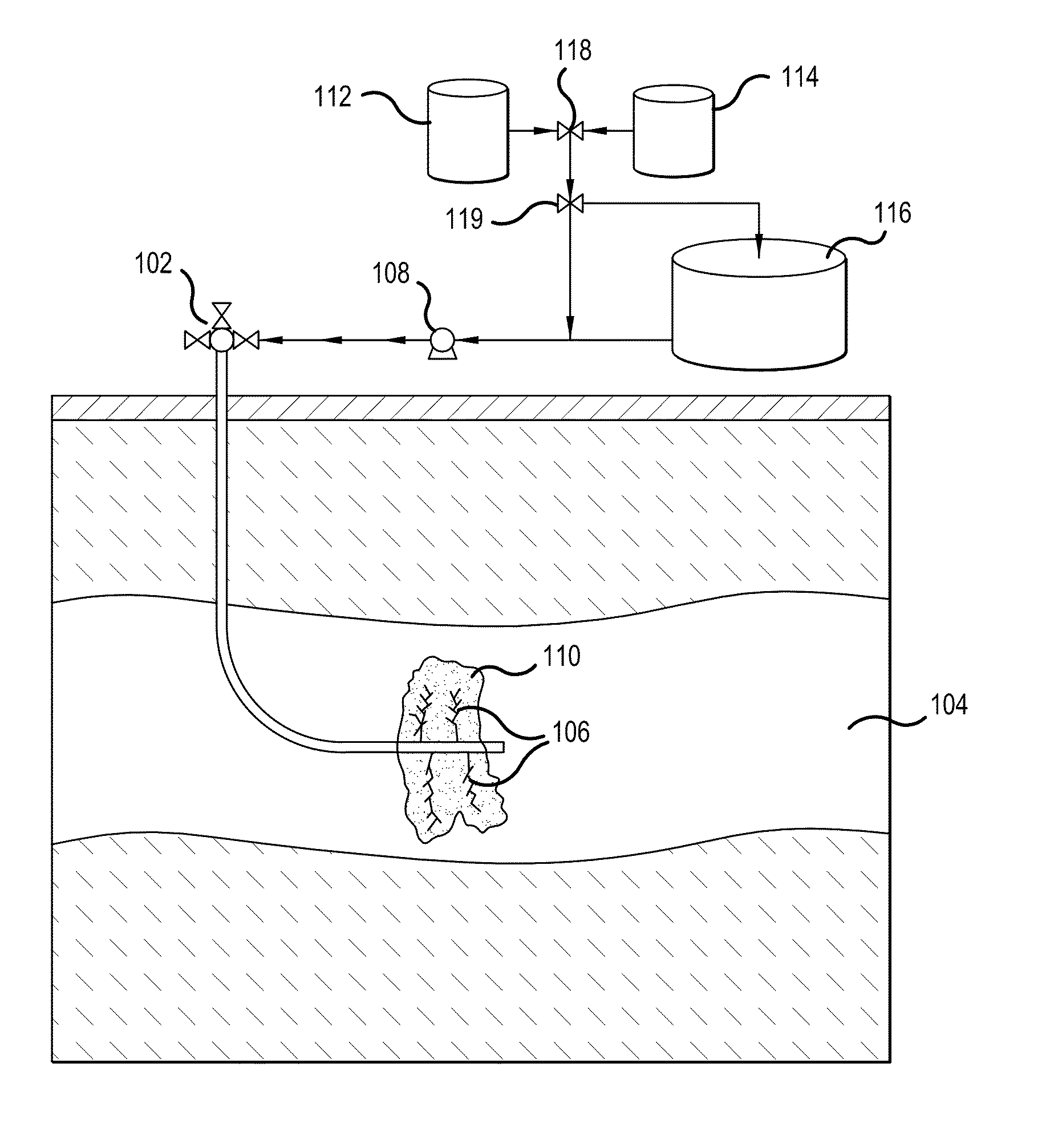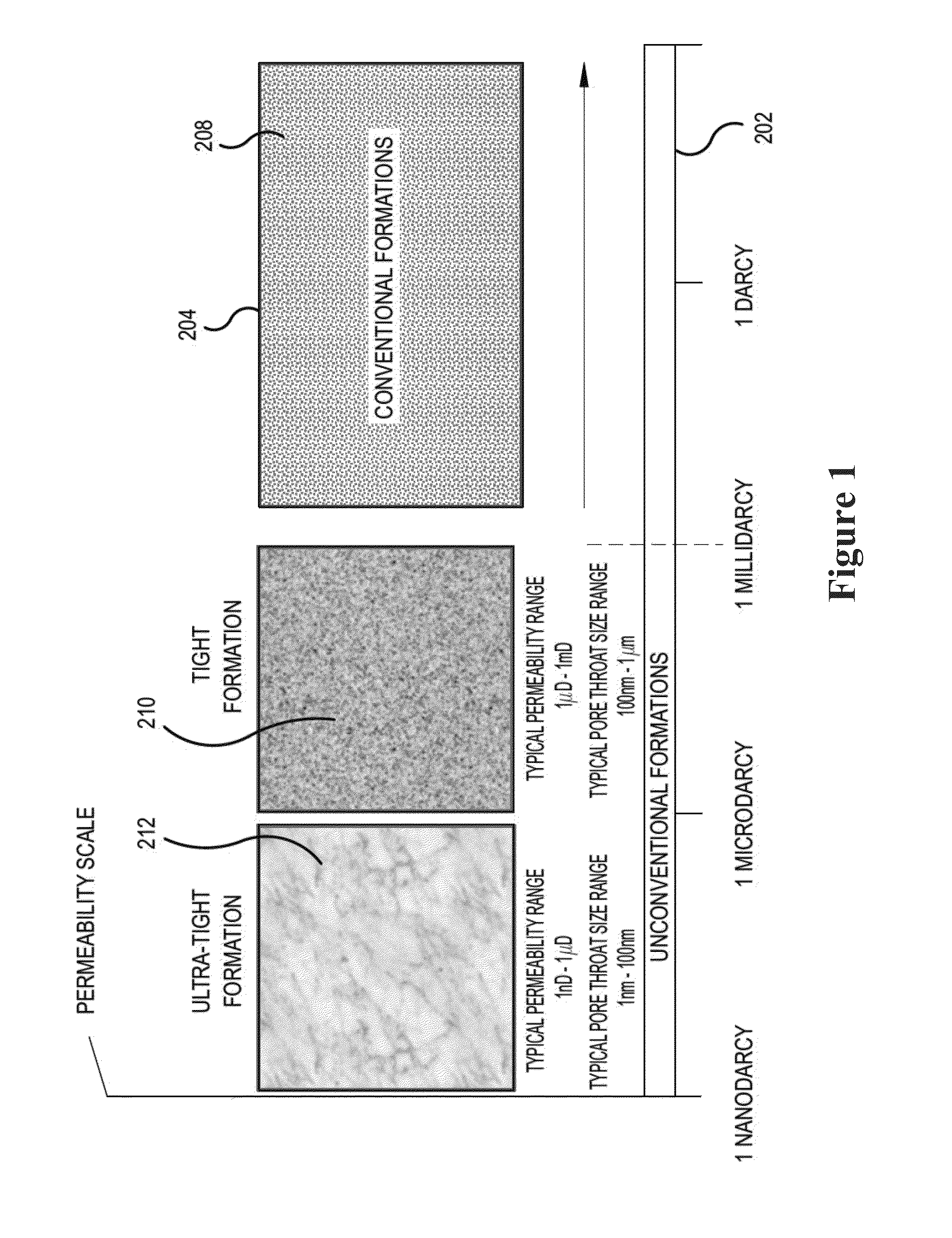Horizontal drilling results in increased reservoir contact with the production well.
Often, high injection rates are required to fracture a subterranean formation effectively.
These high rates result in substantial pressure drops through the well due to friction.
It is largely accepted that low viscosity fluids create more
complex fracture networks with more effective
connectivity to the formation, but these fluids cannot effectively transport or place proppant deep in the formation.
After the fracturing operation, fractures appear in the formation.
Furthermore, during the change from (gel-like) liquid to gas form, the LPG volume increases greatly, thereby increasing the pressure in the formation and further extending fractures.
Compared to many other methods of
hydraulic fracturing, the method based on LPG does not leave chemical substances in the soil and also reduces the effect of
reflux.
This operation creates issues with handling the added chemicals and also with handling large amounts of water (when the
fracturing fluid is water-based).
The cost of proppant may be up to 10% of the drilling costs.
Extracting hydrocarbons from shale reservoirs can be difficult because the shale formation is of low
porosity and
low permeability, so fluid hydrocarbons may not be able to find a path through the formation towards a production well.
As such, when a well is drilled into the formation, only those fluid hydrocarbons in proximity to the well are produced, as the other hydrocarbons farther away from the well have no easy path to the well through the relatively impermeable rock formation.
The use of resin coated proppants is incompatible with the temperatures required for
kerogen pyrolysis.
Furthermore, flow of hard proppants may cause
erosion to pipes, production equipment and to the rock itself.
Oil production rates from such reservoirs under primary depletion often dramatically decline, resulting in oil rates that are only a small fraction of the initial production rates in a relatively short time.
Oil
recovery is further impeded by large water cuts (that is, the ratio of water produced in comparison to the total volume of liquids produced) during primary depletion, which can range upwards of 80% in some cases.
The disadvantages of these gelled fluid systems include high
pipe friction if gelling is not delayed, excessive formation damage if the breaking of macromolecules is not adequate, a limited rate and pressure can be applied to the formation, and only a limited stimulated reservoir area is covered compared to slickwater systems.
In addition, complicated
chemistry designs are required.
In addition to the disadvantages of gelled fluids discussed above, the foams and emulsions can be expensive and usually have a high friction pressure compared to other gelled fluids and slickwater.
The disadvantages of slickwater include poor proppant suspension and transport compared to gelled fluids, limited
fracture conductivity generation, and formation damage due to deposition of macromolecules.
The disadvantages of the
hybrid gel systems include the same inherent formation and
fracture conductivity disadvantages as with gelled fluid and slickwater.
However, the
hybrid gel
system will have limited proppant suspension and transport with the slickwater portion of the treatment and will have limited producible stimulated reservoir area with the gelled fluid portion of the treatment.
These fluids are applied to reservoirs where water-sensitivity adversely impacts production and where aqueous fluids may cause significant (and sometimes irreversible) formation damage (e.g.,
coal bed methane formations or any formations with appreciable swelling clays).
However, pure CO2 and N2 cannot carry proppant effectively and near well bore
conductivity could be compromised.
In addition, non-aqueous fluids (particularly
nitrogen and
carbon dioxide) may be applied to a limited subset of reservoir types due to costs, relatively high matrix leakoff, and relatively poor proppant transport.
Though oil recovery from unconventional reservoirs is economical today, a number of challenges (e.g., fast decline rates and low ultimate recoveries) restricting the full potential of these reservoirs still exist.
While the
hybrid stimulation methods used today with aqueous systems (in comparison to crosslinked fluid systems typically used in conventional reservoirs) did help increase fracture surface area and partially overcome deficiencies related to the low
matrix permeability, access to the bulk of the reservoir (i.e., producible stimulated reservoir area) is still very limited using these methods for two primary reasons.
The first reason is the lack of stimulated area per volume of reservoir (i.e, limited number of stimulated fractures per volume of reservoir), and the second reason is restricted flow paths in un-propped, fractured reservoirs due to
water damage.
Water-based fluids may also damage narrow fractured pathways due to clay swelling and fines migration, interfacial tension with reservoir hydrocarbons, and gelling agents used in the stimulation fluids.
 Login to View More
Login to View More  Login to View More
Login to View More 


